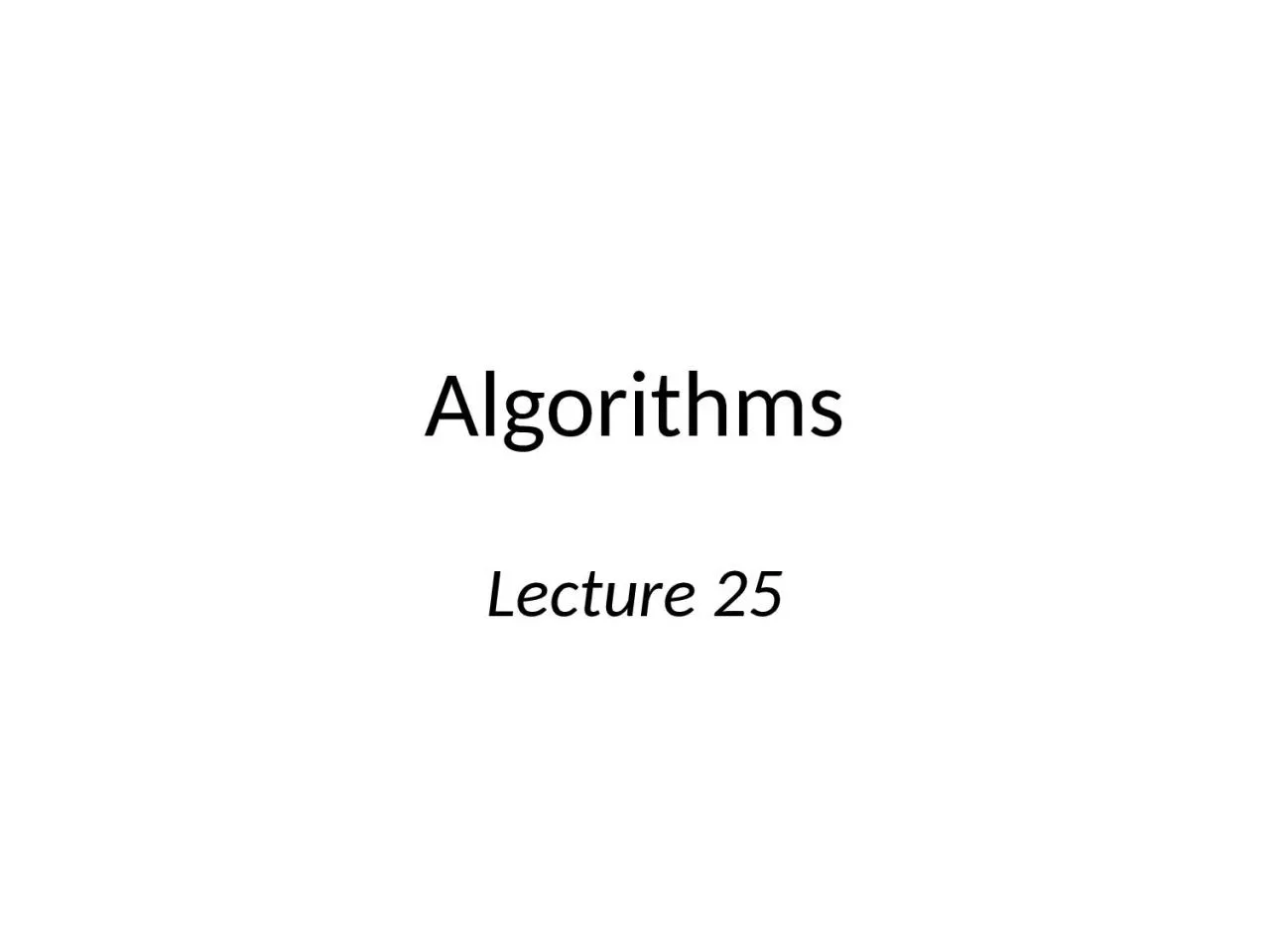

Minimum cut Recall that a cut in a graph is a partition of its vertices into two nonempty subsets A B The size of a cut is the number of edges from vertices in A to vertices in B Ie the number of edges ID: 919332
Download Presentation The PPT/PDF document "Algorithms Lecture 25 Minimum cut" is the property of its rightful owner. Permission is granted to download and print the materials on this web site for personal, non-commercial use only, and to display it on your personal computer provided you do not modify the materials and that you retain all copyright notices contained in the materials. By downloading content from our website, you accept the terms of this agreement.
Slide1
Algorithms
Lecture 25
Slide2Minimum cut
Slide3Minimum cut
Recall that a
cut
in a graph is a partition of its vertices into two non-empty subsets A, B
The
size
of a cut is the number of edges from vertices in A to vertices in B
I.e., the number of edges
crossing
the cut
Min-cut problem: Given a graph G, find a minimum cut
Note: previously we looked at finding a minimum s-t cut
Slide4Minimum cut
Possible to find the (global) min-cut by finding the minimum s-t cut for some s and all t
…but randomized algorithms are simpler; can be more efficient
The algorithm we show can be optimized
Slide5Finding a min-cut
Continually pick a uniform edge in the (multi)graph and contract it, until there are two vertices left; return the resulting edges in the original graph as the cut
Theorem: this returns a min-cut with probability at least 1/
, where n is the number of vertices
Slide6Finding a min-cut
Fix some min-cut C of size k; we show that C is returned with at least the claimed probability
C will be returned unless some edge in C is contracted
What is the probability that no edge in C is ever contracted?
Let Bad
i
be the event that an edge of C is contracted in step
i
Let Goodi be the complement of Badi
Slide7Finding a min-cut
Consider the first step
G has at least k n/2 edges
Each vertex has degree at least k, or else C would not be a min-cut
Pr
[Bad
1
] ≤ k/(
kn/2) = 2/nPr[Good1] ≥ 1 – 2/n
Slide8Finding a min-cut
Consider the second step, assuming Bad
1
did not occur
As before, each vertex has degree at least k; now there are n-1 vertices
Pr
[Bad
2
| Good1] ≤ k/(k(n-1)/2) = 2/(n-1)Pr[Good2 | Good1] ≥ 1 – 2/(n-1)Pr[Good2
Good
1
] =
Pr
[Good
1
]
Pr
[Good
2
| Good
1
]
≥ (1 – 2/n)
(1 – 2/(n-1))
Slide9Finding a min-cut
Continuing in this way, we get
Pr
[
i
Good
i] ≥ (1 – 2/n)(1 – 2/(n-1)) … (1 – 2/3)
=
…
=
= 1/
Slide10Finding a min-cut
The probability that the algorithm finds a min-cut is inverse polynomial, but not
very large
Run the algorithm T times, and take the smallest cut returned!
What is the probability that this finds a min-cut?
Slide11Finding a min-cut
Pr[all executions fail to find a min-cut]
=
i
Pr
[execution
i fails to find a min-cut]
≤ (1 – 1/
)
T
Setting T =
n, we get (1 – 1/
)
T
≤ e-nThis finds a min-cut in polynomial-time with all but tiny probability!
Slide12Max-SAT
Slide13Max-SAT
Given
a 3SAT
formula with k clauses, want to satisfy as many clauses as possible
Idea: set each variable uniformly!
Let N be the number of clauses satisfied
Let
I
c be 1 iff clause c is satisfiedExp[N] = Exp[c
I
c
] =
c
Exp[
I
c] = c = 7k/8This satisfies 7/8 of the clauses in expectation!
Slide14Max-SAT
What if we want to satisfy at least 7/8 of the clauses (with high probability)?
(Note: our analysis here is different from what is in the book)
Markov’s inequality
: If X is a nonnegative
r.v.
and t > 0, then
Pr
[X ≥ t] ≤ Exp[X]/tProof: Exp[X] = i<t
i
Pr
[X =
i
] +
i
≥t
i Pr[X = i] ≥ t i≥t Pr[X = i] = t Pr[X ≥ t]
Slide15Max-SAT
Apply Markov’s inequality to the number N’ of clauses that are
not
satisfied
Exp[N’ + N] = Exp[k] = k
Exp[N’] = k/8
Pr
[N’ > k/8] =
Pr[N’ ≥ (k+1)/8] ≤ k/(k+1)Pr[N ≥ 7k/8] ≥ 1 – Pr[N’ > k/8] ≥ 1/(k+1)Can now compute the expected number of iterations of the algorithm needed, or how many times it is necessary to run the algorithm so it succeeds except with arbitrarily small probability
Slide16Coupon-collector problem
Slide17Problem setup
There are n types of items
Items arrive one-by-one; the items’ types are uniformly distributed and independent
How many items N do you expect to see before getting one of each type of item?
Slide18Analysis
Let N
i
be the number of items you see after having i-1 types, until you get an item of the
ith
type
Exp[N
i
] = ?The probability that the next item will be a new type is (n-i+1)/nSo the expected number of items needed until getting a new type is n/(n-i+1)Exp[N] = Exp[i N
i
] =
i
Exp[N
i
] = n
i
1/(n-i+1)
= O(n log n)
Slide19Application
Recall the contention resolution problem…
In any round, the probability that some machine succeeds is
1/e
Conditioned on the event that some machine succeeds, it is equally likely to be any machine
How many successes do we need in expectation before
every
machine succeeds?
This is just the coupon-collector problem!
How many rounds do we need in expectation before every machine succeeds?